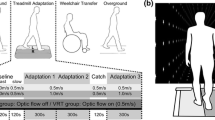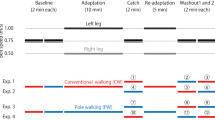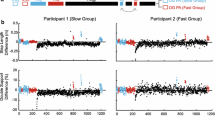Abstract
Patterns of human locomotion are highly adaptive and flexible and depend on the environmental context. Locomotor adaptation requires the use of multisensory information to perceive altered environmental dynamics and generate an appropriate movement pattern. In this study, we investigated the use of multisensory information during locomotor learning. Proprioceptive perturbations were induced by vibrating tactors, placed bilaterally over the plantar surfaces. Under these altered sensory conditions, participants were asked to perform a split-belt locomotor task representative of motor learning. Twenty healthy young participants were separated into two groups: no-tactors (NT) and tactors (TC). All participants performed an overground walking trial, followed by treadmill walking including 18 min of split-belt adaptation and an overground trial to determine transfer effects. Interlimb coordination was quantified by symmetry indices and analyzed using mixed repeated-measures ANOVAs. Both groups adapted to the locomotor task, indicated by significant reductions in gait symmetry during the split-belt task. No significant group differences in spatiotemporal and kinetic parameters were observed on the treadmill. However, significant group differences were observed overground. Step and swing time asymmetries learned on the split-belt treadmill were retained and decayed more slowly overground in the TC group whereas in NT, asymmetries were rapidly lost. These results suggest that tactile stimulation contributed to increased lower limb proprioceptive gain. High proprioceptive gain allows for more persistent overground after effects, at the cost of reduced adaptability. Such persistence may be utilized in populations displaying pathologic asymmetric gait by retraining a more symmetric pattern.





Similar content being viewed by others
References
Berniker M, Kording K (2008) Estimating the sources of motor errors for adaptation and generalization. Nat Neurosci 11:1454–1461. doi:10.1038/nn.2229
Bloomberg JJ, Mulavara AP (2003) Changes in walking strategies after spaceflight. IEEE Eng Med Biol Mag 22:58–62
Collins JJ, Imhoff TT, Grigg P (1997) Noise-mediated enhancements and decrements in human tactile sensation. Phys Rev E 56:923–926. doi:10.1103/PhysRevE.56.923
Duysens J, Trippel M, Horstmann GA, Dietz V (1990) Gating and reversal of reflexes in ankle muscles during human walking. Exp Brain Res 82:351–358
Haudum A, Birklbauer J, Muller E (2014) The effect of external perturbations on variability in joint coupling and single joint variability. Hum Mov Sci. doi:10.1016/j.humov.2014.02.004
Hohne A, Stark C, Bruggemann GP (2009) Plantar pressure distribution in gait is not affected by targeted reduced plantar cutaneous sensation. Clin Biomech (Bristol, Avon) 24:308–313. doi:10.1016/j.clinbiomech.2009.01.001
Kavounoudias A, Roll R, Roll JP (1998) The plantar sole is a ‘dynamometric map’ for human balance control. Neuroreport 9:3247–3252
Kluzik J, Diedrichsen J, Shadmehr R, Bastian AJ (2008) Reach adaptation: What determines whether we learn an internal model of the tool or adapt the model of our arm? J Neurophysiol 100:1455–1464. doi:10.1152/jn.90334.2008
MacLellan MJ, Patla AE (2006) Adaptations of walking pattern on a compliant surface to regulate dynamic stability. Exp Brain Res 173:521–530. doi:10.1007/s00221-006-0399-5
Malone LA, Bastian AJ (2010) Thinking about walking: effects of conscious correction versus distraction on locomotor adaptation. J Neurophysiol 103:1954–1962. doi:10.1152/jn.00832.2009
Mawase F, Haizler T, Bar-Haim S, Karniel A (2013) Kinetic adaptation during locomotion on a split-belt treadmill. J Neurophysiol 109:2216–2227. doi:10.1152/jn.00938.2012
Mawase F, Shmuelof L, Bar-Haim S, Karniel A (2014) Savings in locomotor adaptation explained by changes in learning parameters following initial adaptation. J Neurophysiol 111:1444–1454. doi:10.1152/jn.00734.2013
Mulavara AP, Feiveson AH, Fiedler J et al (2010) Locomotor function after long-duration space flight: effects and motor learning during recovery. Exp Brain Res 202:649–659. doi:10.1007/s00221-010-2171-0
Pestilli F, Carrasco M, Heeger DJ, Gardner JL (2011) Attentional enhancement via selection and pooling of early sensory responses in human visual cortex. Neuron 72:832–846. doi:10.1016/j.neuron.2011.09.025
Peters BT, Miller CA, Brady RA, Richards JT, Mulavara AP, Bloomberg JJ (2011) Dynamic visual acuity during walking after long-duration spaceflight. Aviat Space Environ Med 82:463–466
Reisman DS, Block HJ, Bastian AJ (2005) Interlimb coordination during locomotion: What can be adapted and stored? J Neurophysiol 94:2403–2415. doi:10.1152/jn.00089.2005
Reisman DS, Wityk R, Silver K, Bastian AJ (2009) Split-belt treadmill adaptation transfers to overground walking in persons poststroke. Neurorehabil Neural Repair 23:735–744. doi:10.1177/1545968309332880
Rosenkranz K, Rothwell JC (2012) Modulation of proprioceptive integration in the motor cortex shapes human motor learning. J Neurosci 32:9000–9006. doi:10.1523/JNEUROSCI.0120-12.2012
Smith MA, Ghazizadeh A, Shadmehr R (2006) Interacting adaptive processes with different timescales underlie short-term motor learning. PLoS Biol 4:e179. doi:10.1371/journal.pbio.0040179
Speers RA, Paloski WH, Kuo AD (1998) Multivariate changes in coordination of postural control following spaceflight. J Biomech 31:883–889
Torres-Oviedo G, Bastian AJ (2012) Natural error patterns enable transfer of motor learning to novel contexts. J Neurophysiol 107:346–356. doi:10.1152/jn.00570.2011
van Vliet PM, Wulf G (2006) Extrinsic feedback for motor learning after stroke: What is the evidence? Disabil Rehabil 28:831–840. doi:10.1080/09638280500534937
Vasudevan EV, Bastian AJ (2010) Split-belt treadmill adaptation shows different functional networks for fast and slow human walking. J Neurophysiol 103:183–191. doi:10.1152/jn.00501.2009
Zehr EP, Haridas C (2003) Modulation of cutaneous reflexes in arm muscles during walking: further evidence of similar control mechanisms for rhythmic human arm and leg movements. Exp Brain Res 149:260–266. doi:10.1007/s00221-003-1377-9
Zehr EP, Nakajima T, Barss T et al (2014) Cutaneous stimulation of discrete regions of the sole during locomotion produces “sensory steering” of the foot. BMC Sports Sci Med Rehabil 6:33. doi:10.1186/2052-1847-6-33
Zhang S, Li L (2013) The differential effects of foot sole sensory on plantar pressure distribution between balance and gait. Gait Posture 37:532–535. doi:10.1016/j.gaitpost.2012.09.012
Acknowledgments
This study was supported by funds from the NASA Experimental Program to Stimulate Competitive Research (EPSCoR) award number NNX11AM06A, the National Institute of General Medical Sciences of the National Institutes of Health award number P20GM109090 and award number 1I01RX000604 from the Rehabilitation Research and Development Service of the VA Office of Research and Development. The content is solely the responsibility of the authors and does not necessarily represent the official views of the NASA, NIH or the VA Office of Research and Development.
Author information
Authors and Affiliations
Corresponding author
Rights and permissions
About this article
Cite this article
Mukherjee, M., Eikema, D.J.A., Chien, J.H. et al. Plantar tactile perturbations enhance transfer of split-belt locomotor adaptation. Exp Brain Res 233, 3005–3012 (2015). https://doi.org/10.1007/s00221-015-4370-1
Received:
Accepted:
Published:
Issue Date:
DOI: https://doi.org/10.1007/s00221-015-4370-1




